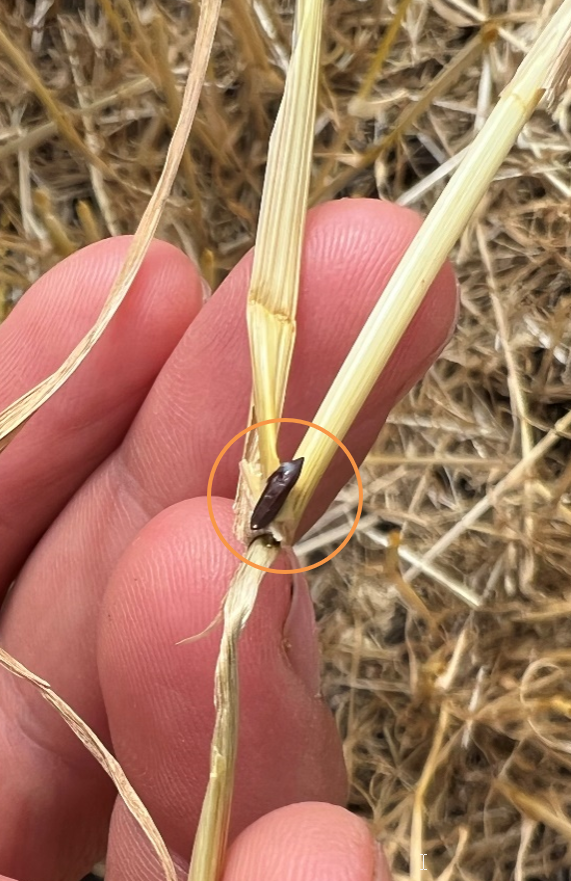Hessian Fly Problems in Wheat
This page was adapted from the article, "Hessian Fly Problems in Wheat ," which appeared in Crop & Pest Report on September 22, 2022
Hessian fly was observed infesting spring wheat near Olga in Cavalier County. They were weakening the stems causing some to break or lodge usually right above the second node. Most stems were broken, with 1-2 flaxseed-like maggots (Figure 1) but some stems had as many as 6 maggots (Source: Jeremy Sauer, AgriVantage Crop Consulting). The field had a significant infestation, almost 5% of heads were lodged or not harvestable. Northwest Minnesota also reported high pressures of Hessian fly near the Beltrami area and the least amount of pressure in the fields closest to Crookston (Source: Dr. Jochum Wiersma, UMN).

Hessian fly prefers wheat (all types – spring, winter, durum) as a host. Other hosts are barley, rye, triticale, winter rye, and winter barley. In addition, several wild grasses (quack grass, ryegrass) can be infested by Hessian fly as well as volunteer wheat.
Hessian fly has two generations per year in the Northern Great Plains. The fall flaxseed stage larvae that we are seeing now will pupate and then the second-generation flies emerge in late August into September. Female flies search for suitable hosts to lay eggs in like winter wheat, volunteer wheat, rye cover crops, grassy weed hosts and other seeded grass crop in the fall.
Larvae will hatch from the eggs in 3 to 10 days and feed on the plant for two weeks developing into the flaxseed stage. They overwinter in the flaxseed stage. Fall planted grass crops that are infested with Hessian fly are stunted, and plants will generally die in the four-leaf stage during the winter. Next May, adult flies will emerge and females will lay eggs in spring planted grass crops to continue their life cycle.
Some sustainable pest management strategies include:
- Choose suitable cover crops that are not known hosts of Hessian fly.
Do not use wheat, barley, or rye as cover crops in areas with severe Hessian fly populations, since they are favorable to their reproduction and feeding. Oats are less favorable to Hessian fly egg laying and feeding. However, Hessian fly appears to be adapting to rye since it is commonly planted as a cover crop and available in the fall for egg laying. - Destroying volunteer wheat in spring before planting and planting winter wheat after the Hessian fly dates: after September 1-15 in the northern ND and after September 15-30 in the southern ND.
By destroying the volunteer wheat and planting winter wheat later, the life cycle of Hessian fly is broken. As flies emerge, there is no place for them to lay eggs. - The high labeled rate of insecticide seed treatments on wheat (Cruiser and Gaucho) can be used at planting time to reduce Hessian fly infestations. Research has shown that a pyrethroid insecticides applied shortly after wheat emerges (at or before the two- to three-leaf stage) have been effective against Hessian fly. If applied at the right time, a pyrethroid insecticide kills adult flies and may also kill young larvae before they become embedded behind the leaf sheaths. However, insecticides are rarely warranted in ND due to typical low populations of Hessian fly.